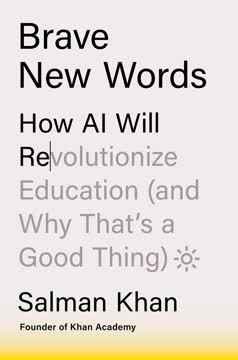Key Takeaways
1. Intelligent Automation (IA), or Hyperautomation, is the #1 technology trend transforming work.
IA is becoming so ubiquitous and impactful that it has been listed as the number one technology trend for 2020 by Gartner.
A new revolution. Intelligent Automation (IA), also known as Hyperautomation, represents a new generation of software-based automation focused on knowledge work ("white-collar" tasks). Unlike previous industrial revolutions that automated manual labor, IA targets information-based activities performed by professionals like lawyers, accountants, and call center agents. This shift is profoundly impacting the global economy.
Mimicking human abilities. IA achieves automation by mimicking core human capabilities used in knowledge work: Vision (seeing/interpreting), Execution (doing/acting), Language (reading/speaking/understanding), and Thinking & Learning (analyzing/deciding). By combining technologies that replicate these abilities, IA creates "digital workers" capable of performing complex processes with minimal human intervention.
Rapid adoption and growth. Despite being a relatively new concept (coined in 2017), IA has seen explosive growth and adoption. Over 50% of the world's largest companies are already implementing IA, and this rate is expected to exceed 70% soon. The market for related technologies like machine learning and RPA is experiencing rapid growth, attracting significant investment and acquisitions by major tech companies.
2. IA is a business imperative, essential for survival and competitive advantage in the digital age.
According to a study by Statista, 84% of business organizations adopt AI because it gives them a competitive advantage over their rivals.
Digital natives' advantage. The business landscape is rapidly changing, favoring newer, highly automated digital-native companies. Older, less automated organizations struggle to keep pace, evidenced by the decreasing average tenure of companies on indices like the S&P 500. Adapting legacy businesses is challenging due to inertia and complexity, making digital transformation a matter of survival.
Driving efficiency and growth. IA offers significant benefits for businesses, addressing top CEO priorities like cost control, productivity, and new growth opportunities. Unlike traditional multi-year transformation programs, IA initiatives can deliver payback in less than a year and achieve efficiency gains of 20-60%. Early adopters gain a competitive edge with higher profit margins and faster free cash flow acceleration.
Building new strategies. IA is foundational for innovative business strategies like building new digital businesses from scratch and creating data ecosystems. Examples include:
- Lego's digital ventures (video games, social networks) boosting profits.
- Goldman Sachs launching the Marcus online loan platform.
- Ping An expanding into healthcare and smart city ecosystems based on data.
These strategies leverage IA to create faster, cheaper, and more seamless customer experiences while enabling data monetization and cross-selling.
3. IA dramatically improves both employee and customer experiences by automating tedious tasks and augmenting capabilities.
enterprises that drive initiatives to enhance employee experience are four times more profitable than those that do not.
Liberating employees. A significant portion of employee time is spent on unproductive, routine, and administrative tasks (estimated at 42% automatable). IA can automate these mundane activities, freeing employees to focus on more valuable, engaging, and creative work. This shift is crucial given that 85% of employees globally report feeling disengaged with their current work.
Boosting engagement and productivity. Improving employee experience is directly linked to profitability and talent retention. IA acts as a key lever by:
- Automating routine tasks (e.g., data entry, report generation).
- Augmenting capabilities (e.g., providing data insights for better decision-making).
- Eliminating wasteful activities (e.g., excessive emails, inefficient meetings).
This "Triple-A artifact" approach helps transition employees towards an ideal state where they spend more time on productive, value-adding activities.
Enhancing customer satisfaction. Customers today expect responsive, omnichannel, and personalized service available 24/7. IA enables this by:
- Powering intelligent chatbots and virtual agents for immediate support (e.g., Vodafone reducing call times).
- Analyzing customer data to create customized offers and predict needs (e.g., Netflix saving $1 billion annually through recommendations).
- Augmenting human agents with real-time information and guidance (e.g., Wyndham Hotels using RPA for check-in/out).
IA can make up to 80% of a customer journey digitally touchless, leading to significant increases in customer satisfaction (NPS) and reductions in contact center workload.
4. Beyond business, IA has the potential to save millions of lives and trillions of dollars annually, addressing major global issues.
IA can avoid $10 trillion of losses every year (e.g., by reducing fraud, errors, and work-related diseases and accidents).
Reducing massive losses. Fraud, errors, and work-related accidents/diseases cost the global economy trillions of dollars annually. IA offers powerful solutions to mitigate these losses:
- Fraud: Using machine learning and blockchain to detect and prevent fraudulent transactions (e.g., Amex preventing $2 billion in fraud).
- Errors: Automating administrative tasks to reduce human error, particularly in healthcare (estimated $1 trillion cost in the US, 86% administrative).
- Work-related issues: Monitoring stress levels, reducing workload, and performing risky tasks to decrease accidents and diseases ($3 trillion annual cost globally).
Saving lives. IA has the potential to prevent millions of early deaths each year (estimated 10-30% reduction in annual fatalities). Key applications include:
- Healthcare research: Accelerating drug discovery and clinical trials.
- Disease diagnosis: Analyzing medical images with higher accuracy and speed than humans (e.g., DeepMind detecting AKI two days earlier).
- Avoiding medical errors: Checking prescriptions and monitoring patients in real-time (e.g., preventing fatal medication errors).
- Addressing healthcare shortages: Providing remote consultations and delivering medical supplies via drones in underserved areas.
- Reducing traffic fatalities: Using computer vision and AI in autonomous vehicles (potential 94% reduction).
Funding global priorities. The estimated $10 trillion in annual savings from reducing fraud, errors, and accidents is roughly equivalent to the combined global expenditure on education and health. Redeploying even a portion of these savings could dramatically increase funding for education, healthcare, environmental protection, or eliminating hunger.
5. IA mimics human capabilities – Vision, Execution, Language, Thinking & Learning – by combining various technologies.
IA automates knowledge work by mimicking four main capabilities of workers: execution, language, vision, and thinking & learning.
The four pillars. IA systems are built by combining technologies that replicate human capabilities. These four core capabilities are:
- Vision: Perceiving and interpreting visual information (documents, images, videos). Technologies include OCR, ICR, image/video analysis, and biometrics.
- Execution: Performing actions in digital environments (typing, clicking, routing data). Technologies include smart workflow, low-code platforms, and Robotic Process Automation (RPA).
- Language: Understanding, interpreting, and generating human language (text, speech). Technologies include Natural Language Processing (NLP), intelligent chatbots, unstructured information management, and speech analytics.
- Thinking & Learning: Analyzing data, creating insights, predicting, and making decisions. Technologies include big data management, machine learning (regression, decision trees, clustering, deep learning), and data visualization.
Creating synergies. While individual technologies offer benefits, combining capabilities unlocks much broader and more impactful applications. For example, automating a bank's client onboarding process can involve:
- Language (chatbots for interaction).
- Vision (ICR for document processing).
- Thinking & Learning (analytics for risk assessment).
- Execution (RPA/workflow for data entry and routing).
This integration creates end-to-end, touchless processes that deliver significantly higher value than isolated automation efforts.
Building on existing IT. IA is not meant to replace foundational systems like ERPs or mainframes. Instead, it sits on top of the existing IT landscape, automating the human interactions with these systems. IA technologies act as tools used by the "digital workforce" to operate the existing infrastructure, adding intelligence and automation layers.
6. Successful IA transformation requires strong management support, clear governance, and a focus on people and process redesign, not just technology.
Succeeding at an IA transformation is not easy, nor is it guaranteed.
Beyond the pilot phase. While implementing IA pilots is relatively easy, scaling them across an organization presents significant challenges. Many initiatives fail to achieve widespread adoption and sustained benefits due to issues beyond just the technology itself.
Critical success factors: Based on hundreds of implementations, key factors for scaling IA include:
- Management Support & Vision: Top-down sponsorship, enterprise-wide vision, and clear objectives.
- Governance & Structure: Establishing a Center of Excellence (CoE) for implementation/innovation and an Automation Operation Center (AOC) for maintenance.
- Process Redesign: Optimizing or radically redesigning processes before automating them (using lean or zero-based approaches), focusing on high-value end-to-end processes.
- Data Management: Treating data as a valuable asset, ensuring quality, consistency, and breaking down silos.
- Talent Management: Identifying, retraining, and reskilling employees, often recruiting internally.
- Change Management: Educating, engaging, and incentivizing employees and managers to embrace IA and collaborate with technology.
Addressing resistance. Resistance to change, fear of job loss, and managers' concerns about losing status are significant barriers. Transparent communication, education about the benefits (less tedious work, new opportunities), and clear career pathing are essential to build buy-in and make employees authors of the transformation.
7. New enablers like democratization, technology convergence, and IA generating IA are accelerating the scaling of automation.
New concepts and technologies are emerging from the market to help solve these issues.
Democratizing IA. Making IA accessible to a broader range of users beyond specialized developers is crucial for scaling. Low-code and no-code platforms empower business users ("citizen developers") to build their own automation solutions with minimal training. This increases implementation speed and embeds IA into the organizational culture.
Convergence of technologies. The trend is moving towards integrating the four core IA capabilities (Vision, Execution, Language, Thinking & Learning) into more comprehensive platforms. Enterprise software vendors and cloud providers are building integrated suites, and APIs are becoming critical for connecting diverse systems and data flows seamlessly. The future may see single technologies acting as one-stop shops for multiple capabilities.
IA generating IA. Automating the process of building and managing IA applications itself is a powerful enabler. Technologies are emerging that can:
- Identify and assess automation opportunities automatically (process discovery, process mining, data discovery).
- Generate automation code automatically (automated code generation).
- Automate tasks typically performed by data scientists (AutoML).
- Monitor and maintain IA applications proactively, predicting and addressing failures.
These advancements significantly reduce the time, cost, and human effort required for IA transformations.
8. IA is central to the Fourth Industrial Revolution, fundamentally reshaping the future of work and society.
Now, we have entered into the fourth industrial revolution, which is about intelligent and connected technologies, of which IA is a central component.
A new era of disruption. Following the revolutions of steam, mass production, and digital technology, the world is now in the Fourth Industrial Revolution, characterized by the convergence of digital, physical, and biological spheres. IA, with its ability to automate intelligent tasks and connect disparate systems, is a driving force behind this transformation.
Impact on knowledge work. Just as previous revolutions automated agriculture and manufacturing, IA is automating "white-collar" knowledge work, which now constitutes over 80% of jobs in developed economies. This shift has profound implications for employment, skills, and the structure of society.
Accelerated pace of change. Unlike previous revolutions that unfolded over decades or centuries, the pace of change in the Fourth Industrial Revolution is exponential, driven by rapid advancements in computing power, data generation, and AI algorithms. This accelerated pace poses a significant challenge for societies to adapt and retrain their workforces in time.
9. The future of work presents optimistic and pessimistic scenarios; preparing for both through societal imperatives is crucial.
The actual outcome will most likely be between optimistic (Scenario 1) and pessimistic (Scenario 2).
Optimistic scenario. This view holds that, like past revolutions, IA will ultimately create more jobs than it displaces. New occupations related to developing, managing, and working alongside IA will emerge, leading to increased productivity and higher living standards. Studies predict a net positive creation of millions of jobs globally in the coming years.
Pessimistic scenario. This view argues that "this time is different." The nature and pace of AI's advancement, particularly its ability to automate intelligence itself, may lead to a massive displacement of human workers that outstrips the creation of new jobs. The speed of change may also prevent societies from adequately retraining their populations, potentially leading to widespread unemployment and social unrest.
The need for preparedness. Regardless of which scenario fully materializes, the significant disruption is inevitable. Societies must prepare for a future where human workload is potentially reduced. This requires proactive planning and implementation of societal-level imperatives to mitigate risks and ensure a positive outcome for humanity.
10. Adapting education and skills is vital, shifting focus from knowledge acquisition to creativity, critical thinking, and continuous learning.
The future of work will be a race between education and technology.
Beyond technical skills. As IA automates more tasks, including some technical ones, the most valuable human skills are shifting. The focus must move beyond rote knowledge acquisition towards capabilities that machines struggle with.
Essential future skills: Key skills for thriving in the age of IA include:
- Adaptability and "learning how to learn": The ability to continuously acquire new skills as technology evolves.
- Insight generation: Moving from "knowledge workers" (manipulating information) to "insight workers" (applying judgment, intuition, critical thinking).
- Creativity: Generating novel ideas and solutions that surprise even advanced AI.
- Socio-emotional skills: Empathy, collaboration, and resilience.
- Moral compass: Purpose and personal ethics.
Transforming education. Education systems must be reinvented to cultivate these skills from an early age. This involves:
- Shifting curriculum focus (e.g., Finland's 4 Cs: communication, collaboration, creativity, critical thinking).
- Expanding education to lifelong learning for all ages.
- Leveraging technology and new pedagogies for more personalized and engaging learning experiences.
Massive, government-led educational transformations, similar to the US High School Movement, are needed globally to prepare the workforce.
11. Sharing the wealth created by IA and rethinking the very definition of "work" are necessary for a more human-centric society.
There seems a general rule that the more obviously one’s work benefits other people, the less one is likely to be paid for it.
Addressing inequality. Technological progress has historically exacerbated wealth inequality, favoring skilled labor and capital owners. As IA drives further productivity gains with potentially fewer workers, mechanisms are needed to ensure wealth is shared more equitably.
Universal Basic Income (UBI). UBI is proposed as a potential solution to provide a safety net, ensuring everyone has a basic standard of living regardless of employment. Pilots suggest UBI can improve well-being and potentially free individuals to pursue education or contribute to society in non-traditional ways, aligning with Maslow's higher needs.
Rethinking "work". The current definition of work, often characterized by stress, disengagement, and tedious tasks, is unsustainable and unfulfilling for many. IA offers an opportunity to redefine work, potentially reducing mandatory hours and shifting focus to activities uniquely human and meaningful:
- Spending time with family and loved ones.
- Pursuing creative, artistic, or leisure activities.
- Caring for others and contributing to community well-being.
- Addressing global challenges like climate change.
This requires a cultural shift away from defining self-worth solely by paid employment.
Building a new society. The ultimate imperative is to leverage IA to build a more human-centric society. This involves governments proactively planning for the transition, redefining societal values beyond economic contribution, and creating spaces and opportunities for individuals to pursue fulfilling activities. The goal is a future where autonomous technology provides for material needs, allowing humans to focus on connection, creativity, and purpose.
Last updated:
Review Summary
Intelligent Automation receives mostly positive reviews, praised for its comprehensive coverage of IA and its potential impact on business and society. Readers appreciate its insights into implementation challenges and future scenarios. Some find it optimistic about IA's benefits, while others value its balanced approach. Critics note disorganization and overreliance on IA as a solution. The book is recommended for those interested in understanding the Fourth Industrial Revolution and its implications for various professions.
Similar Books










Download PDF
Download EPUB
.epub digital book format is ideal for reading ebooks on phones, tablets, and e-readers.




